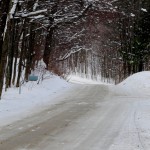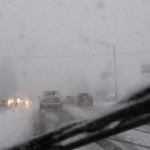Winter weather (bitter cold temperatures, snow and ice) is almost here and drivers need to remember to take extra care. Every year it seems that there are more accidents during the first couple of snowstorms as drivers tend to forget how to drive on snow and ice. An earlier post, Drivers Prepare: Winter Weather Is Arriving Soon, discussed how you should know your vehicle functions and features, having your vehicle in good working condition and by preparing a safety kit. This post offers tips and suggestions for driving in winter weather, snow and ice.
BEFORE YOU START YOUR TRIP 
It is important to be prepared before driving on snow and ice. Assuming you have already followed the tips from our other post there are other steps you should take shortly before going out:
Clear off the vehicle: Make sure you clear and remove all snow and ice that would obscure the driver’s vision. On windy days, snow from the hood or roof can blow onto the windshield, and either temporarily block the driver’s view, or if the temperature is cold enough, could freeze on the windshield. In addition, at night or on vehicles with daylight running lights, make sure to clear and clean your headlights. This helps both the driver and other vehicles.
Check the road conditions: You should check the road conditions before leaving, especially if driving outside of a city. Make sure the roads are open and whether they have been plowed, salted or sanded. For travel in Nebraska, the Nebraska Department of Roads has a specific section on their website, General Travel Information and Links (viewable here) that provides road condition information. For the most current Nebraska information, you can call 511 or 800-906-9069. Other states have similar websites and information and many also use 511.
Check the weather conditions: You should check the weather conditions, both for the time you are leaving but what they are expected to be throughout your trip. Besides just checking on snow or precipitation you should also be aware of the temperature. If there is ice on the road, the colder it is the longer it will take to stop.
Clothing: Make sure you are dressed appropriately for the weather. You never know if you are going to get stuck or stranded.
Decide: You need to decide how necessary the trip is especially when it is currently snowing or if there is a lot of snow or ice that has not been plowed. If the trip is not that important, you should postpone until it is safer.
Driver Readiness: The driver needs to be ready to drive as driving on snow and ice is much more difficult and requires more concentration than driving on dry pavement. The driver should be fully awake, alert and not under the influence of alcohol or other substances that affect his or her ability to drive.
Time: Make sure you allow plenty of time to get where you are going. Remember that it takes more time to get from Point A to Point B in winter driving conditions. Do not rush to get someplace when the roads are slick. It is better to be late than drive faster and increase your risk of getting into an accident.

DRIVING ON SNOW AND ICE
After you are adequately prepared and have decided it is safe enough to travel, you need to remember that vehicles operate differently on snow and ice than on dry pavement. Here are some general tips and suggestions for driving safely on snow and ice:
Control: Avoid sudden acceleration, braking and steering, all of which can cause loss of control of your vehicle.
Cruise control: Do not use cruise control on snow or ice. It is dangerous because if your car starts to skid, the cruise control will continue to spin the wheels to maintain speed causing the vehicle to become even more out of control.
Driving lanes: When travelling on a roadway with 2 or more lane going in the same direction, try to drive in the lane that has the least amount of snow. However, be cautious as there may be “black ice”, which you cannot see. If forced to choose between driving on snow or ice, snow is the better choice as it provides some traction. In addition, you should avoid changing lanes as much as possible because you may lose control of the vehicle when driving over snow that has built-up between lanes.
Following: As it takes more distance to stop your vehicle on snow or ice, you need to keep even more distance between your vehicle and the vehicle in front of you. Normal following distance on dry pavement is usually 3 to 4 seconds. For driving on snow and ice, should increase to 8 to 10 seconds.
Speed: Drive more slowly on snow or ice. It takes a much longer distance to stop your vehicle on snow or ice than you would on dry pavement due to reduced traction. It only takes a small amount of snow or ice to cause the roads to become slick. Speed limits are based on normal, dry, paved roads. If you are driving the normal speed limit on a snowy or icy road, you are driving to too fast.
Turning: You should start braking before you start to enter a corner. When you reach the corner release the brakes and begin your turn. Once the turn is completed, you can start to accelerate.
SUDDEN AND EMERGENCY SITUATIONS
If confronted with having to perform a sudden or emergency maneuver, we suggest the following:
Evasive Maneuvers: When trying to avoid a collision with an object in front of your vehicle, the speed of your vehicle determines what you should attempt. If you are driving over 25 mph, steering is preferred to braking as less distance is required to steer around something than to try and stop your vehicle.
Skidding: Skids can be caused by a number of things, including braking suddenly, rapid acceleration and traveling too fast on a curve. If your vehicle begins to steer you should: (1) Take your foot off the accelerator; do not slam or rapidly pump the brakes; (2) Steer in the direction you want the front of the vehicle to go (for example, if the rear of the vehicle is sliding to the right, turn the steering wheel to the right); and (3) When the skidding stops, maintain steering to avoid a skid on the other side.
Sudden Stops: The proper method to try and stop quickly on snow or ice is dependent on whether the vehicle has antilock (ABS) brakes. However, ABS does not make a vehicle stop more quickly; ABS only helps prevent the wheels from locking, which may cause a loss of steering control.
If the vehicle has ABS, press the brake pedal firmly; do not pump the brake pedal. The wheels make lock briefly causing the brake pedal to vibrate or shake. This is normal.
If the vehicle does not have ABS, you should pump the brake pedal rapidly to prevent the wheels from locking up and causing a skid.
Vehicle stuck: If your vehicle gets stuck in the snow, try the following:
- Do not slam on the accelerator or spin your wheels;
- Accelerate slowly to ease your car out;
- Turn your wheels from side to side to push snow out of the way;
- Use a shovel to clear snow away from the wheels and the underside of the car;
- Put sand, gravel or salt in the path of the wheels for traction; and
- Rock the vehicle forward and backward by pressing on the accelerator and switching the transmission from forward and reverse repeatedly (Check your Owner’s Manual- this can damage the transmission on some vehicles).
SOURCES
These tips and suggestions are from a number of sources, including: Nebraska Driver’s Manual (2010); Nebraska Department of Motor Vehicles; Nebraska Department of Roads; California Department of Motor Vehicle; AAA Exchange: How to Drive on Snow and Ice brochure; Edmunds.com; National Highway Traffic Safety Administration (NFTSA); National Safety Council; Federal Motor Carrier Safety Administration (FMCSA).
CONCLUSION
Driving in winter driving conditions can be challenging. The key to safe driving is to be prepared, alert and under control. These tips can help you arrive at your destination safely. The best tip is stay home if the roads are bad; even if you drive safely other drivers may not.
OTHER POSTS INVOLVING DRIVING
Drivers Prepare: Winter Weather Is Arriving Soon
Drivers: Beware of Deer
Drivers Understand But Often Ignore Risks of Texting or Talking on Cell Phone
Distracted Driving: Risks Inside Your New Car or Truck
ABOUT LAPIN LAW OFFICES
Lapin Law Offices urges Nebraska drivers to stay safe this time of year by being prepared and driving carefully.
 If you have been injured in a motor vehicle accident due to the fault of another driver, whether on snow, ice or other any other cause, please contact Lapin Law Offices (402-421-8033 anytime) for a free consultation to learn about your rights and what we can do for you. We represent clients with caring, passion and dedication.
If you have been injured in a motor vehicle accident due to the fault of another driver, whether on snow, ice or other any other cause, please contact Lapin Law Offices (402-421-8033 anytime) for a free consultation to learn about your rights and what we can do for you. We represent clients with caring, passion and dedication.
